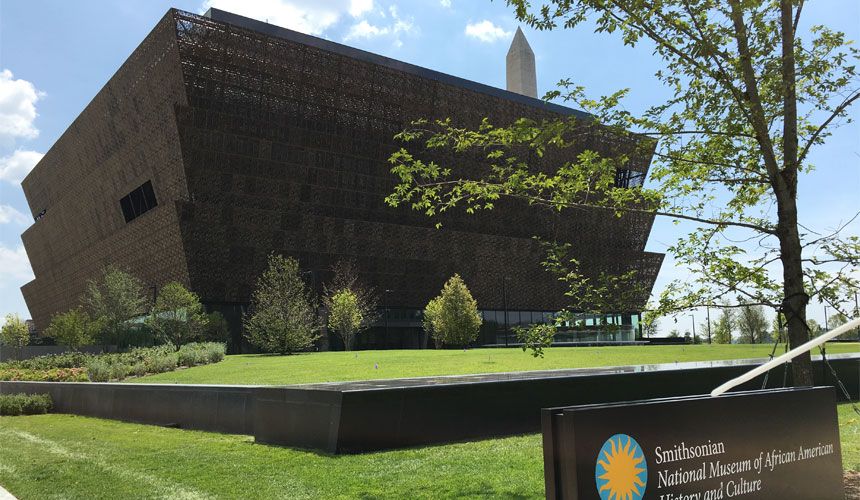Indie podcast featuring Black designers joins the Smithsonian collection
The same year Revision Path’s 300th episode featured Academy Award winning production designer Hannah Beachler (of , , and fame), it also reached another milestone. A tremendously significant milestone, in fact: it is the first podcast to be included in the permanent collection of the Smithsonian’s National Museum of African American History and Culture (NMAAHC). Yes, that’s right: the first podcast.
Since 2013, the indie podcast has featured the work of Black graphic designers, web designers, software developers, creative and art directors, illustrators, animators and other digital creatives. With its recent inclusion into the NMAAHC permanent collection, it becomes a testament to a few trends: the evolution of design, the continued rise of podcasts as a venue for discussion of arts and culture, and the growing public interest in how the design industry works.
Revision Path’s creator and host Maurice Cherry himself is a wealth of knowledge worthy of inclusion in national archives, so we asked him to answer a few questions to help us understand the cultural impact of design and how podcasting has changed since 2013.
August 2018 — I went with a group of friends (including some former guests on the show). We spent pretty much the whole day in the museum, viewing all the exhibits from the basement up to the top floor. It was great to not only take in all the culture and history, but to also be able to discuss it with other design professionals as well. It was truly a wonderful experience.
They are all professionals in design in their own unique way, and they are all Black — that’s the primary thing they have in common. The truth is that there’s a lot of diversity in the episodes that were chosen. There is gender diversity, age diversity, diversity in discipline, diversity in sexual orientation, and diversity in geographic location. When people listen to the episodes as a set, I guarantee that they will come away with knowledge about a wide array of information. The perspectives shared in these conversations really are a good display of what Revision Path is all about.
That is a great question. I certainly feel that the overall visibility and perception of Black designers in the design community has grown over the past six and a half years. I think Revision Path has played a in that, but I certainly cannot take credit for it all. The guests on the show come from all walks of life from all over the world, and their work spans a wide range of design, tech, and other creative fields. When they are on the show and others listen and learn about them, it just spreads the word about the fact that Black designers are out here working, thriving, and making a difference in the world.
Podcasting has certainly gotten a lot more commercial over the years. I started podcasting in the early 2000s, so I have seen that big first flush of indie podcasting come about, as well as media companies and their podcasts. NPR, for example, created podcasts from several of their shows as far back as the mid-2000s. This second wave of podcasting, which I would say probably could be traced back to around the time of and its big mainstream success in 2014, has brought more indie podcasters into the field, but major media outlets (TV, newspapers, etc.) have also stepped up their production and their output.
The technology (hardware and software) to record, edit, and produce podcasts has become a lot easier and more accessible, but the gap between indie podcasters and big media organizations is widening every day. The big media organizations have the resources to crank out high quality shows, and have a staff to support the marketing and distribution. Indie podcasters are often doing all that work themselves, or through hiring others to handle these services on a contract basis. And as I alluded to earlier, it has gotten a lot more commercial. There are lots of talk about sponsors and making money which might make some think of podcasting as some "get rich quick" scheme. And with dynamic ad insertion and other new tracking technologies, advertisers are getting more savvy about which shows they financially support in order to maximize a return on their investment.
What I think ends up happening then is that shows are created just for the sole purpose of making money, and not about telling stories or sharing information or connecting with a wider audience.
More interviews! Revision Path’s strength is its consistency, so we will continue having new episodes every Monday at 10am ET. Now that we have crossed 300 episodes, I have thought about having more of our past guests come back and talk about what has happened since their last interview. Huny Young, who has been on the show three times now, is a great example of someone who has evolved throughout her creative career, and it is so great to chart her creative journey from 2015 to 2017 to 2019.
I definitely want to do more of those kinds of interviews with past guests. Also, because Revision Path is very much an international show, I want more international guests! We have been fortunate to have guests from North America, the Caribbean, and throughout Europe, Africa, and Australia. I would love to talk to more Black designers in parts of Asia, as well as throughout South America.
I think we can all gain so much perspective from what our brothers and sisters throughout the diaspora are doing in design, and that is something that people don’t learn about in design school.

